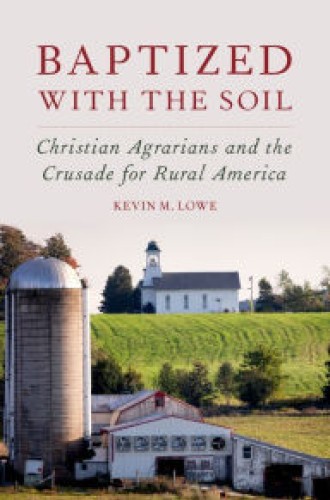The kingdom of God is like a farm
Nineteenth-century agrarians believed that community is more important than the individual and solidarity is more important than profit.
This book could be categorized as a paean to the rural life movement in U.S. Protestantism during the first half of the 20th century. Alternatively, it might be seen as a powerful precursor of Christian ecotheology and other contemporary trends. Both are accurate.
Kevin Lowe presents a new history of agrarianism, which opposed the industrialization of agriculture primarily because of its negative impact on rural communities. Participants in the movement believed that community is more important than the individual, solidarity is more important than profit, and one should put one’s neighbor and the Earth before oneself. These tenets are both currently relevant and blatantly nostalgic.
Read our latest issue or browse back issues.
What is most striking in this history is the degree to which agrarian thinkers of the early 20th century believed that they should and could influence national policy. These Christian leaders boldly claimed that they were building the kingdom of God and that God was present in their work. They called on legislators, presidents, and other citizens to support their vision. And they succeeded. Theodore Roosevelt created the Commission on Country Life, intended to promote rural development, and FDR helped create farm subsidy legislation. What emerges from this story is how many current programs and organizations have antecedents in that movement.
The word agrarianism referred to a belief in social leveling through the equal distribution of land. Although land is not the basis of the current push for a livable wage, the Fight for Fifteen movement—calling for an increase in the minimum wage to $15 an hour—certainly champions a greater degree of equality. Today agrarianism also refers to the importance of place, stability, work, and the health of the land. It seems anachronistic in its opposition to industrialization and modernization, but the goals of this conservative movement have a fascination for those who identify themselves with the goals of the Social Gospel.
Each of the early chapters of the book is devoted to a central tenet of the Christian agrarian crusade: commitment to the viability of the family farm; devotion to rebuilding the Christian church as the center of the community; construction of the kingdom of God, including material improvement of the lives of rural people; and development of a theology of environmental stewardship as faithful Christian treatment of the land. In championing the family farm, Christian agrarians were supporting the value of the local rural community, family-operated farms rather than tenant farms, the virtues they believed were generated by families, and the belief that a family ought to be able to be economically independent. Though family farming has largely given way to corporate structures, many of these family communal and economic values continue to be powerful.
The movement worked to strengthen the rural church and community by developing seminary courses in rural ministry for pastors, laypeople, and rural missionaries. These programs continue in specific rural ministry curricula at a number of seminaries, in commissioned lay-pastor programs in most Protestant denominations, and in the National Catholic Rural Life Conference.
Two programs that were designed to “construct the kingdom of God” were Rural Life Sunday, which continues today, and the Lord’s Acre movement. The Lord’s Acre, a multigenerational devotion to raising and selling one acre of produce and donating the money to the church, became a popular and spiritually generative activity that took a number of forms beyond the farm. Its descendants include the Foods Resource Bank, Heifer International, Kiva, and other microfinance programs.
Lowe emphatically ascribes to Christian agrarians the roots of the environmental stewardship commitment to the care of land. Tracing the beginning of the movement to the 1915 publication of Liberty Hyde Bailey’s The Holy Earth, Lowe demonstrates the cooperation of soil conservation services, the extension movement, and the development of an ecotheology during the 50 years that followed. These early roots have blossomed into the Earth Community movement and programs to combat climate change. Many such initiatives are now cooperative and ecumenical.
Lowe has done the millions of pastors and congregants of small-membership churches a tremendous service by recovering the proud roots of rural ministry in the United States. His excavation and documentation of archival materials is exceptional. And the engaging narrative quality adds to the inspiration this book holds for present-day descendants of Christian agrarianism.







